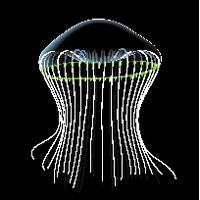Nobel Prize in Chemistry for the discovery and applications of fluorescent green protein
The fluorescent green protein (GFP) was first seen in the medusa victory in 1962. Since then, the protein is very interesting for scientists, since it is very useful for many trials. This allows, among other things, to observe the growth of tumors and brain development of Alzheimer's disease. Specifically, this protein can be used to know the chemical reactions that occur in cells. For this purpose, the protein adheres to the molecule that interests the scientist and emits fluorescence by absorbing light from the outside. Thus, the molecule that he wants to see remains in view of the scientist.
Medusa light

Aequorea victory marmoka. (Photo: Nobel Foundation)
Osamu Shimomura has always based his research on the study of the bioluminescence of victory. This animal has the capacity to generate its own light and Shimomura wanted to investigate the green light generated by this jellyfish. To do this, he isolated the fluorescent protein GFP of this animal and discovered that the external brocel of the jellyfish released calcium ions that when adhering to the aequorin protein emitted blue light.
The GFP protein contains 238 amino acids, of which three (Ser65-Tyr66-Gly67) react to each other and give a special chromium. Shimomura saw that the GFP protein contained this peculiar chromosome, a group of atoms that absorbed and emitted light. When ultraviolet or blue light collides against this chromium of the GFP, it absorbs the energy of light, that is, it excites. Then, the cromoforo releases this energy and then emits green light. Thus, in the medusa victory, the GFP chromoforum turns the blue light into green light. That's why these two proteins emit a different color.
The highlight is: The GFP protein needs no other component to shine, just radiate it with ultraviolet or blue light. However, aecuurine and other bioluminescence proteins need molecules that provide additional energy.
After these investigations, the American Chalfie proposed the application of the GFP protein to the activator gene of a complete process to observe the processes initiated by this activating protein. Green light would clarify all these processes.
Finally, Roger. And Tsi studied the reaction mechanism and found that replacing these three essential amino acids absorbed and emitted light from other areas of the spectrum. After several amino acid junctions, the American researcher discovered that the GFP emitted cyan, blue and yellow. In this sense, at present, researchers can mark proteins with different colors to analyze, among other things, their interactions.
Buletina
Bidali zure helbide elektronikoa eta jaso asteroko buletina zure sarrera-ontzian











